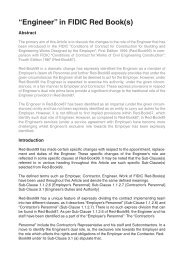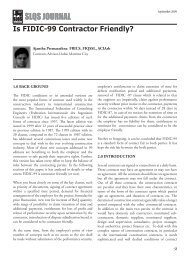SLQS-Journal Vol. 1 - Slqs-uae.org
SLQS-Journal Vol. 1 - Slqs-uae.org
SLQS-Journal Vol. 1 - Slqs-uae.org
You also want an ePaper? Increase the reach of your titles
YUMPU automatically turns print PDFs into web optimized ePapers that Google loves.
<strong>SLQS</strong> JOURNALJanuary 2009Final project cost and duration can be estimated using twoapproaches: deterministic forecasting and probabilisticforecasting (Barraza et al. 2004). Project forecastinginvolves predicting the outcome of a future event. Risksand uncertainties in future events makes project forecastinga difficult process. Traditionally, project planners predictthe most likely outcomes of future events and generate adeterministic plan based on these outcomes. The majorlimitation of the deterministic plan is that it considers onlyone single outcome and ignores all the other possibilities.Probabilistic or stochastic planning approach was evolved toaddress the limitation of deterministic planning. Probabilisticplanning considers variability in project parameters anddevelops stochastic cost and schedule estimates for theproject. Monte Carlo simulation is a commonly used tool ingenerating probabilistic project estimates and schedules. Thispaper describes a new and innovative tool that integratesEVM and probabilistic project planning and control.2.Earned Value Management SystemThe most attractive feature of Earned Value Management isits unique metrics. This metrics consists of key parameterswhich are the building blocks of the earned value managementsystem, performance measures and forecasting indicators.Through this metrics, Earned Value Management integratesthe project scope, cost and schedule. Earned value performancemeasures and forecasting indicators are calculated from threeparameters of project scope, cost and schedule. Conceptuallythe earned value management system integrates the costand schedule measurement. Figure 1 provides a graphicalrepresentation of the three parameters on a project Time –Cost graph. The three key parameters of EVM are:1. Planned Value (PV) or Budgeted Cost of Work Schedule(BCWS): Planed Value is the cumulative budgeted cost ata given time point on the baseline schedule. The plannedvalue graph provides the budgeted time – cost combinationfrom the project start to the project end. Calculation ofBCWS is based on the baseline schedule and the projectbudget.2. Earned Value (EV) or Budgeted Cost of Work Performed(BCWP): Earned value is equal to the cumulative budgetcost of the work completed. This integrates the budgetinto the actual progress of the project. The actual costand the earned value represent the same amount ofwork completed, but differ in the value as earned valuecost the completed work according to the budget rates.As this uses the original budget rates to value the workcompleted, it represents the value of the work earned bythe project performer.3. Actual Cost (AC) or Actual Cost of Work Performed(ACWP): Actual Cost is the cumulative project cost thatwas incurred at a given time point of the project. Thedetails relating to the actual cost is exclusive from thebaseline budget or the schedule. The actual cost incurredfor each time unit is derived through the cost accountingsystem.ProjectProgressActual cost ofwork performed (ACWP)CVSVBudgeted cost ofwork scheduled (BCWS)Budgeted cost ofwork performed (BCWP)Figure 1: Graphical presentation of key Earned ValueParametersEarned Value Management has originated as a projectmonitoring tool that integrates the cost and the schedule.The EVM metric consists of number of performance measuresdeveloped to monitor the project progress. There are twotypes of performance measures, namely, variance measuresand index measures. The variance calculates the deviation ofthe actual performance from the baseline as an absolute figurewhile the index reports the deviation as a ratio. Though thevariance in an absolute figure, it does not provides- deleteda good indication on the magnitude of the deviation acrossthe whole project time line. Performance measures used inEVM are Cost Variance (CV), Cost Performance Index (CPI),Schedule Variance (SV) and Schedule Performance Index (SPI).A variance with a smaller value at the early stage of the projectmay have a larger relative deviation than a larger variance atthe later stages of the project. Hence, the index provides abetter monitoring indicator compared to the variance. Costvariance (CV) compares the earned value of the project ata certain time point against the actual cost at that point.The following formulas calculate the cost variance and costperformance index.Cost Variance (CV) = Earned Value (BCWP) – Actual Cost(ACWP). (1)Cost Performance Index (CPI) = Earned Value (EV)/ ActualCost (AC) (2)Both the earned value and the actual cost represent the sameamount of work completed up to the calculation point butuse different cost rates. A positive cost variance indicates afavourable situation where actual cost incurred is less thanthe anticipated value according to the budget. CPI comparesearned value against actual cost in the form of a ratio. AnIndex Value greater than 1 indicates a favourable projectsituation. General schedule monitoring tools measure theschedule variation in time units, though, the earned valueTime31





